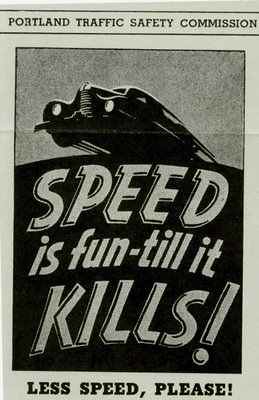
(Yet Another Traffic Gripe)
Sorry for the annoyance, but hey, if you are a motorist but haven't yet started using your body (walk, run, bicycle, skateboard) to get around, the message needs to be made.
This morning a motorist passed me on a narrow stretch with no shoulder and an oncoming car. No, "Brenna" (as her vanity plate read) didn't get over into the other lane; I could have reached out and touched her car as she passed.
As I explained to a friend later, "I had a moment of inattention." Really, that's how I'm beginning to see it. There seems to be a natural human inclination tendency to decide that if it's possible to pass a cyclist without crossing the yellow line, then it is safest to do so.
Yeah, right. For everyone except the cyclist.
The frustrating irony of it is that when a motorist chooses to cross over the center line, they will almost always give me plenty of room. There's a psychological threshold that gets crossed when a motorist goes over the center line. I don't even think it's an issue of a motorist being in a hurry. When I force a motorist to wait, I never get a sense that they're frustrated or impatient. (I know, never is a strong word. It could happen one day, but it hasn't yet.)
So, it's my responsibility to control the situation. Whenever it is unsafe to pass, I will move far enough to the left. (Thanks, Hal Ballard. Your advice to "control the lane" is becoming more and more central to my defensive cycling practice now.)
So why am I writing about this? I've discussed this before, and I'm probably preaching to the choir anyway. The point is, the Uniform Vehicle Code and the Oregon Revised Statutes both state that cyclists are to ride "as far to the right as practicable."
My concern is that I am taking a very liberal interpretation of this phrase. I found myself wishing (as "Brenna" turned onto Huntington, clearly another non-local using my side street as a through street short cut) that the legislature would grant me some specific allowances for these kinds of situations: passing over a solid yellow line, passing on a bridge, passing when oncoming traffic precludes achieving a safe distance).
According to John Forester, only three percent of all bicycle-motor vehicle accidents involve the cyclist being overtaken by the motor vehicle from the rear. I find myself arguing vehemently with people who think it's safer on the sidewalk that they are deluding themselves. (They're actually less safe, but that's another topic.)
And yet...
There is no other time that any vehicle travels as close to any other vehicle as when a motorist commits one of these unsafe passes of a cyclist. Think of it: even when you're traveling in adjacent lanes on a freeway you don't pass another automobile with such little clearance. Even when a cyclist is in an adjoining bike lane, you don't pass so closely.
Although I disagree with the cyclists who ride on the sidewalk, I sympathize with their concern. These unsafe passes, in my not-so-humble-opinion, are the most dangerous situations that I face with any type of frequency.
I understand the scorn of the Dutch blogger who said that American cyclists need helmets because they fall so much (evidently Dutch cyclists are thirty times less likely to get in an accident than American cyclists, and if you google on this you'll see there's quite a bit of controversy about whether helmets are worthwhile). However, I don't think it's the American cyclist that's the problem; it's the American motorist.





No comments:
Post a Comment